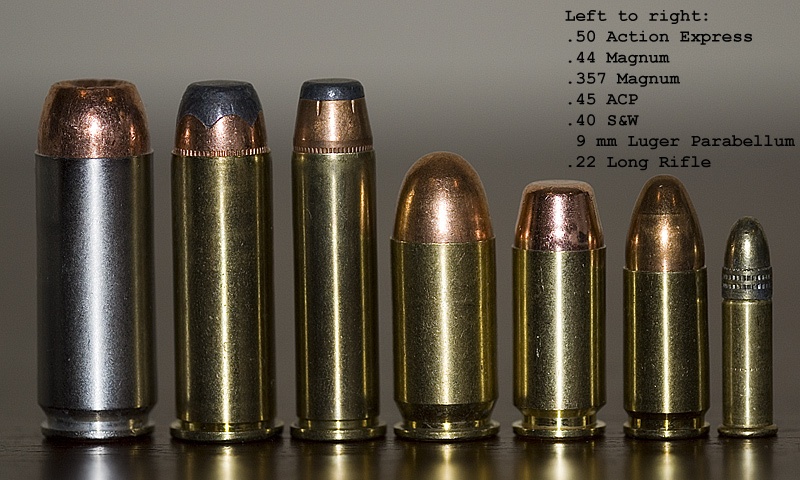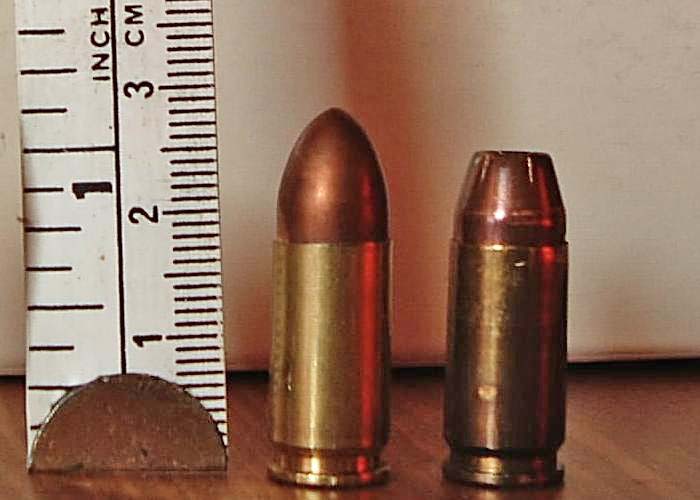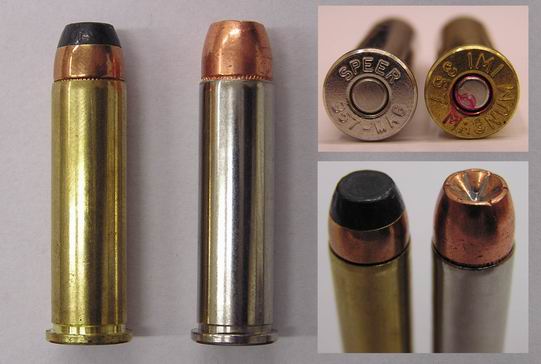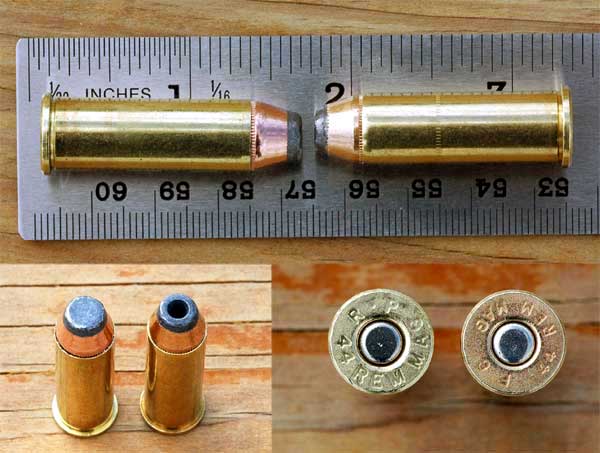
These are a list of different handgun cartridges and information you will need to know. Go through the links and determine what you like best. I prefer the .45 ACP personally.
List of handgun cartridges
http://en.wikipedia.org/wiki/List_of_handgun_cartridgesI will cover the most popular rounds
9x19mm Parabellum
The 9x19mm Parabellum is a pistol cartridge introduced in 1902 by the German weapons manufacturer Deutsche Waffen und Munitionsfabriken (DWM) for their Luger pistol.[2]. Its parent cartridge was the 7.65x22mm Parabellum, itself a descendant of the earlier 7.65x25mm Borchardt cartridge. The 9 mm Parabellum is used in pistols, submachine guns, and carbines.
The name Parabellum is derived from the Latin: Si vis pacem, para bellum ("If you seek peace, prepare for war"), which was the motto and telegraphic address of DWM.
PerformanceThe 9 mm cartridge combines a flat trajectory with moderate recoil. Its main advantages lie in its small size and low use of resources for manufacturing. Its main disadvantages are its tendency to overpenetrate and small wound cavity size when nonexpanding bullets are used.
Read more here
http://en.wikipedia.org/wiki/9x19mm_Parabellum.40 S&W
The .40 S&W (10x22mm) is a rimless pistol cartridge developed jointly by Winchester and Smith & Wesson, two famous American firearms manufacturers. [1] It uses .400-inch (10.16 mm) diameter bullets ranging in weight from 135 to 200 grains (9 g to 13 g) and operates at about 33,000 psi (230 MPa) pressure.
PerformanceThe .40 S&W cartridge has become a huge success in the United States because, while possessing nearly identical accuracy[7], drift and drop, it adds 50% more energy over the 9 mm Parabellum with a more manageable recoil than the 10 mm Auto cartridge. In the rest of the world it has become a popular combat pistol shooting sports cartridge.[citation needed]
.40 S&W Load Tables
.40 S&W Load Tables
The energy of the .40 S&W exceeds all standard-pressure and +P 9x19mm Parabellum loadings and many standard-pressure .45 ACP rounds, generating between 450 and 600 foot-pounds (550 J and 800 J) of energy, depending on bullet weight, with mid to high 500 foot-pounds typical. Both the .40 S&W and the 9 mm Parabellum operate at a 35,000 psi (240 MPa) SAAMI maximum, compared to a 21,000 psi (150 MPa) maximum for .45 ACP[8]. Some small ammunition manufacturers offer .40 S&W ammunition consistently developing energy well above 500 ft·lbf (700 J) in all their .40 S&W ammo as off-the-shelf items.[9]. While SAAMI has not established a +P standard for the .40 S&W, there are companies marketing ammunition claimed to be +P, but they do not provide pressure data to support +P labeling.
The .40 S&W is considered by some[citation needed] the best cartridge for law enforcement use available today, combining superior stopping power when using expanding ammunition and manageable recoil in a package that remains compact, even when using a double-stack magazine. The .40 S&W has an overwhelming share of the U.S. law enforcement market as a result.[citation needed]
Despite the .40 S&W's great popularity amongst American law enforcement and the private sector[citation needed], it has yet to be adopted by a significant number of military forces worldwide. The mainstay for military use in the western world largely remains the preserve of the 9 mm Parabellum, or for a few special forces, .45 ACP in their respective adopted handguns. The United States Coast Guard, however, has adopted the Sig Sauer P229R DAK in .40 S&W as their standard sidearm.
There are two major reasons for western militaries' choice of ammunition. The first reason is quite simply that the .40 S&W is not a NATO cartridge, and standardization is very important for logistical purposes.
The second major reason for .40 S&W not being chosen by military forces is the expense of procurement, purchasing and stocking spare parts, training of weapons techs to service and repair firearms, etc. The handgun is primarily a secondary firearm in the military forces of any country, and the expense does not justify whatever improvement is available over 9 mm equipment currently in stock for a secondary firearm. Special units, of course, are often free to use whatever they feel best suits their purposes and have designated funding to deal with that.
Since American law enforcement agencies are not bound by these constraints, most have chosen the .40 S&W round for its excellent ammunition capacities, accuracy, and superior ballistic performance.
Read more here
http://en.wikipedia.org/wiki/.40_S%26W.357 SIG
The .357 SIG pistol cartridge is the product of Swiss firearms manufacturer SIG-Sauer, in cooperation with the American ammunition manufacturer Federal Cartridge. SIGARMS (now called SIG SAUER), in partnership with Federal Cartridge, developed the 357 SIG cartridge in 1994. While it is based on a .40 S&W case necked down to accept .355 inch bullets, the .357 SIG brass is longer. See the Handloading section for more information.
PerformanceBecause of its relatively high velocity for a handgun round, the .357 SIG offers a very flat trajectory, which in turn allows the firearms chambered for it more effective range. However, it does not quite reach the performance of the venerable .357 Magnum with bullets heavier than 125 grains, or with typical commercial loadings using 125 grain bullets (e.g., fired from a four-inch barrel, a typical commercial .357 Magnum load propels a 125-grain bullet to 1450 ft/s, while a typical .357 SIG load propels the same bullet to 1350 ft/s). Specialty loads, such as Double Tap Ammunition, are able to propel a 125-grain bullet to 1450 ft/s from a four-inch barrel. Offsetting this general slight disadvantage in performance is the fact that semi-automatic pistols tend to carry considerably more ammunition than revolvers.
However, this comparatively high velocity can also create the potential for overpenetration. The .357 SIG, much like the .357 Magnum and the similarly necked 7.62mm Tokarev, is well-suited for use with bullets that are designed to defeat body armor. Also like the Tokarev, the .357 SIG works well when shooting through barriers. There has been a documented case in Texas where a police officer's .45 round did not penetrate a tractor-trailer's shell, but a .357 SIG round from a backup officer's gun did, killing the suspect inside.[2] The round's ability to penetrate barriers is the main reason for its adoption by law enforcement agencies.
The reputation that the .357 SIG round had for losing its crimp (allowing for bullet setback) was partially true when the cartridge was new and ammunition manufacturers were just beginning to produce the round. These problems have since been corrected by major manufacturers. As a result, the round now exhibits nominal setback characteristics, similar to other cartridges.[citation needed]
The bottleneck shape of the .357 SIG cartridge makes feeding problems almost non-existent. This is because the bullet is channeled through the larger chamber before being seated entirely as the slide goes into full battery. Flat point bullets are seldom used with other autoloader platforms because of feeding problems; however, such bullets are commonly seen in the .357 SIG chambering and are quite reliable, as are hollow-point bullets.
One disadvantage of the .357 SIG is that it fires a .355" bullet at higher velocities than most bullets of that caliber are designed for. Very few bullets have been designed specifically for the .357 SIG, and .357 Magnum bullets that are designed for the same velocity range cannot be used due to their slightly larger diameter. Because of this, there are fewer ammunition choices in .357 SIG than one might expect for a cartridge using .355" bullets.
Another drawback of the .357 SIG is its often harsh treatment of the pistols that are chambered for it. Many are designed to fire the .40 S&W and are later modified for use with the .357 SIG. Firing regularly at pressure levels effectively beyond what the pistol was originally engineered for tends to translate to accelerated wear on the firearm.
The "Accurate Powder" reloading manuals claims that it is "without a doubt the most ballistically consistent handgun cartridge we have ever worked with."[3]
Read more here
http://en.wikipedia.org/wiki/.357_SIG.45 ACP
The .45 ACP (Automatic Colt Pistol, 11.43x23mm) is a rimless pistol cartridge designed by firearms designer John Browning in 1905, for use in his prototype Colt semi-automatic .45 pistol—a design which evolved into the M1911 pistol adopted by the U.S. Army in 1911.
The .45 ACP would become one of the most successful cartridges of all time, among both military and civilian users. It has been used in innumerable handguns and submachine guns since its introduction.
Performancehe result is one of the world's more effective combat pistol cartridges, one that combines very good accuracy and stopping power for use against human targets. The cartridge also has relatively low muzzle blast and flash, as well as moderate recoil. The .45ACP also operates at a relatively low maximum chamber pressure rating of 21,000 psi (145 MPa) (compared to 35,000 psi/240 MPa for 9mmP and .40S&W, 37,500 psi/260 MPa for 10mmAuto, 40,000 psi/280 MPa for .357SIG), which helps extend service life of weapons it is fired in.
Like many pistol cartridges, it is a low-velocity round, and thus not particularly effective against body armor. Another drawback for large scale military operations is the cartridge's large size, weight, the increased material cost of manufacture compared to the 9 mm Para cartridge, and lack of compliance with Standardization Agreements pertaining to handgun ammunition currently enacted between the US and many of its allies.
Even in its non-expanding full metal jacket (FMJ) version, the .45 ACP cartridge has a reputation for effectiveness against human targets because its large diameter creates a deep and substantial permanent wound channel, although some writers, such as the published work of Marshall and Sanow, have cast the reputation of .45 ACP being the "best" at this task into doubt. Marshall & Sanow's work, while receiving heavy criticism from Dr. Fackler, still show the .45 ACP, loaded with the best hollowpoint bullets, to be a "one shot kill", somewhat better than the 9mm Luger, equal with the .40 S&W, and only a few percentage points behind the "King" of the Marshall and Sanow study - the .357 Magnum. It does not, however, match up to the 9mm Luger, the .40 S&W or the .357 Magnum without the best hollowpoint bullets. The .45 ACP averages 78.5% "one shot kill" while the 9mm Luger averages 87%, the .357 Magnum averages 89.5% with the .40 S&W on top with 91.5% average "one shot kill". The .45 ACP remains one of the top handgun cartridges for stopping power.
Being a moderate-powered round on the energy scale, the wide diameter of the .45 ACP bullets produces a decreased tendency to overpenetrate, which reduces the projectile's possibility of passing through the intended target with enough velocity to injure another person. The combination of stopping power and controlled penetration makes the .45 ACP practical for police use, although numerous issues including: the resulting loss of magazine capacity and the larger size and weight of pistols chambered in this caliber has led more police departments in the USA to adopt sidearms in 9mm Luger, .40 S&W, and .357 SIG.[5] Many US tactical police units still utilize the .45 pistol round, including the FBI's Hostage Rescue Team.[6][7][8] While high capacity firearms are available in .45 ACP, the greater length and diameter of the .45 ACP means that the grip of the pistol must be longer and wider than the grip of a comparable pistol of a smaller caliber; this increase in grip size can make the pistol difficult to use for shooters with smaller hands.
Today most NATO militaries use sidearms chambered for the 9 mm Para cartridge, but the effectiveness of the .45 ACP cartridge has ensured its continued popularity with large caliber sport shooters, especially in the United States. In addition, select military and police units around the world still utilize firearms firing the .45 ACP.
Because all standard .45 ACP rounds fired from handguns or short barreled "submachine" guns are inherently subsonic, it is one of the most powerful pistol calibers available for use in suppressed weapons since subsonic rounds are quieter than supersonic rounds. The latter inevitably produce a highly compressed shockwave, audible as a loud "crack", literally a small sonic boom, while they travel through the air. Suppressors reduce the audible "report" by slowing and channeling the high speed gas generated by the burning/expanding gunpowder before it exits the muzzle resulting in a muffled "cough". Suppressors of course can't act on a supersonic shockwave generated by the bullet breaking the 1100 ft/s sound barrier as this happens after it exits the barrel. The downside to the use of .45ACP in suppressed weapons is that increasing the diameter of the passage through a suppressor decreases its efficiency - thus, while .45ACP is among the most powerful suppressed pistol rounds, it is also one of the loudest. Most .45 suppressors must be fired "wet" (with an ablative medium, usually water) to bring sound levels down to "hearing-safe" (under 140dB, generally).
Read more here
http://en.wikipedia.org/wiki/.45_ACP.357 Magnum
The .357 Magnum is a revolver cartridge created by Elmer Keith, Phillip Sharpe, Winchester,[2][3] and the firearms manufacturer Smith & Wesson, based upon Smith & Wesson's earlier .38 Special cartridge. The .357 Magnum cartridge was introduced in 1934, and its use has since become widespread. This cartridge started the "Magnum" era of handgun ammunition.[4]
PerformanceThis cartridge is regarded by many as an excellent self-defense round; it still enjoys a reputation of being the gold standard of stopping power among handgun cartridges. Some of those who have used it have described a "struck by lightning" reaction in those hit with it. For big game, such as ungulates and bears (which have a substantially sturdier build than humans), it is inferior to the .44 Magnum, .454 Casull, .41 Magnum and other larger magnum rounds. Still, it is a fine small and medium game round and will kill deer very reliably at short range if the right loads (140 grain and heavier hollow-point bullets) are carefully used by a qualified marksman. [5] It has similar stopping power on game to the .45 Long Colt with a much flatter trajectory. It is a very versatile cartridge, and can be used with success for self-defense, plinking, hunting, or target shooting.[6]
Guns in .357 Magnum caliber have the advantage of being able to fire .38 Special ammunition, with its lower cost, recoil, noise, and muzzle flash. It has also become popular as a "dual use" cartridge in short, light rifles like the Old West lever-actions. In a rifle, the bullet will exit the barrel at about 1,800 feet per second (550 m/s), making it far more versatile than the .30 Carbine or the .32-20 Winchester. In the 1930s, it was found to be very effective on steel body armor, and metal-penetrating rounds were once popular in the United States among highway patrol and other police organizations. The .357 revolver has been largely replaced by modern, high-capacity semi-automatic pistols for police use, but is still very popular for backup gun use, and among outdoorsmen, security guards, and civilians for self-defense and hunting.
Read more here
http://en.wikipedia.org/wiki/.357_Magnum.44 Magnum
The .44 Magnum is a large-bore, dual-purpose cartridge designed for revolvers; however it is also used in many rifles as well. It was developed in the mid-1950s by lengthening the .44 Special cartridge. Despite the ".44" designation, all guns chambered for .44 Magnum and its parent use bullets .429in (10.9mm) in diameter.[2] A .44 Magnum revolver or rifle will accept both .44 Magnum and .44 Special ammunition, but a weapon designed for .44 Special will only accept the Special, due to the longer overall length of a .44 Magnum cartridge.
Read more here
http://en.wikipedia.org/wiki/.44_MagnumOther roundsThere are other rounds that are used for self defense but shouldn't necessarily be considered as a first priority for self defense over the cartridges listed above.
.25 ACP
The .25 ACP (6.35 mm) centerfire pistol cartridge is a semi-rimmed, straight-walled pistol cartridge designed by John Browning in 1906.
PerformanceThe use of the .25 ACP allows for a very compact lightweight gun, but the cartridge is short ranged with regards to power, and lacks stopping power, putting it in the same class as the .22 LR rimfire cartridge. Although the .22 is slightly more powerful when fired from equal length short barrels, the .25 ACP is viewed by many as a better choice for personal defense due to its more reliable semi-rimmed centerfire case design. Manufacturers have loaded commercial hollow point bullets to higher velocities than the standard 50 grain FMJ load. Both rounds certainly pose an effective psychological threat against attackers not armed with a firearm. Though not the ideal choice, a .25 ACP firearm is capable of stopping an attacker - if multiple gunshot wounds are inflicted, followed by a swift retreat. Firearms chambered for the .25 ACP cartridge are quite common. Frequently, low-cost, low-quality firearms are manufactured in this calibre.
Read more here
http://en.wikipedia.org/wiki/.25_ACP.380 ACP
The .380 ACP (Automatic Colt Pistol) (also referred to as the "9 mm Short", "9 mm Browning", "9 mm Kurz", "9 mm Corto", "9x17 mm") pistol cartridge is a rimless, straight-walled pistol cartridge developed by firearms designer John Browning. It was introduced in 1908 by Colt, and has been a popular self-defense cartridge ever since.
PerformanceThe .380 ACP is compact and light, but short ranged and having marginal stopping power.[4] Even so, it remains a popular self defense cartridge for shooters who want a light weight pistol with manageable recoil.[5] It is slightly less powerful than a standard-pressure .38 Special and uses 9 mm (.355") bullets. The heaviest bullet that can be safely loaded into the .380 is 115 grains (7.5 g), though the standard has long been 85, 90 or 95 grains (6.2 g). Many consider the .380 ACP to be the minimum cartridge suitable for self defense, while others draw the line at the slightly more powerful .38 Special or at the less powerful .32 ACP.
The .380 has had somewhat of a recent upsurge in popularity due to some very compact and lightweight pistols chambered for it, known as Mouseguns.
[edit] Ballistic Data
A 6.2 g (96 gr) bullet leaves a 100 mm (4-inch) barrel at about 290 m/s (950 ft/s) for a muzzle energy of about 192 foot-pounds (260 joules) of energy.
Read more here
http://en.wikipedia.org/wiki/.380_ACP